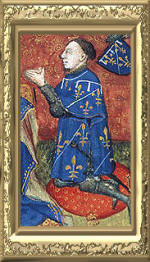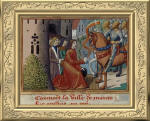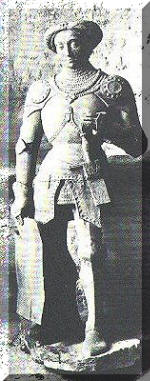|
John of Orléans, Count of Dunois (French Jean d'Orléans,
Comte de Dunois, was the
illegitimate son of Louis d'OrléansThe term "Bastard of Orléans" (bâtard
d'Orléans)
was the usual name for most of his career. In his
era this was a term of respect since it acknowledged
him as a first cousin to the king and acting head of
a His father died in 1407. His half legitimate brother
became an English prisoner at the Battle of
Agincourt
Born at Paris (1403) Jean was the
natural son of Louis I Duc d'Orléans and Mariette
d'Enghien, Dame de Cany. Jean was adopted and raised
faithfully by Louis' wife, Valentina Visconti. As
such Jean was close to Charles, the letigimate heir
and subsequent duc d'Orléans. Charles was captured
at the battle of Agincourt and held prisoner for
many years by the English. The Orléanist cause (as
well as that of the dauphin's) was briefly defended
by Charles d'Orléans younger brother, Philippe,
comte de Vertus, who died suddenly in 1420. Before
his death Philippe arranged to ransom the release of
Jean, who had been held captive by the Burgundians
since 1418.
He joined the civil war in France in
the time of Charles VI. on the side of the Armagnacs,
and was captured by the Burgundians in 1418.
Released in 1420, he entered the service of the
Dauphin Charles VII of France.
Jean, who by his own insistance, went
proudly by the title "The Bastard of Orléans"
continued to fight for the French Valois king and
for the protection of the dukedom against the
English.
Jean took up with La Hire (Etienne de
Vignolles) and Jean Poton de Xaintrailles in
confronting the English when the opportunities
arose. This small force managed to make the English
occupation uncomfortable, even re-captured Le Mans
for a short time. Jean was present at dauphanist's
victory at Baugé (22 March 1421) and defeats at
Cravant (1423) and Verneuil (August 1424).
Jean and La Hire reinforced Montargis
(1427) with 1,600 troops, forcing Warwick to break
off his siege. He became one of the most active
leaders in the defense of Orléans when the city was
besieged by the English in 1428.
|
 |
 |
|
Minature of Jean de Dunois |
Châteaudun, home of Jean de Dunois |
Jean de Dunois was one of the first
military commanders to value Jeanne d'Arc's
participation. His tactful dealing with her
contributed significantly in the success of her
mission to relieve the town of Orléans and took part
in the coronation of Charles VII. In 1436 he aided
in the capture of Paris.
Jean was an active
commander in the post-Orléans campaign of 1429,
where he directed forces in the capture of Jargeau
and was one of the French commanders at the victory
of Patay.
He received
(1439) the county of Dunois from his half-brother
Charles, Duc d'Orléans. Charles VII later made him
count of Longueville. Dunois was prominent in the
conquest of Guyenne and Normandy in the final years
of the Hundred Years War.
Made comte de
Dunois, Jean (still preferring to go by the
expression 'the Bastard') led the army that captured
Le Mans the last time (1448), and Rouen (1449). He
was made lieutenant-general of Charles VII's army, a
position just below that of Constable.
|
 |
 |
|
Surrender of Mantes by the English
to Jean de Dunois |
Jean de Dunois,
de Brézé
and Jacques Coeur
in the campain Guyenne |
Dunois was the dauphin Louis' forces
that relieved Dieppe (August 1443). Dunois was one
of the commanders in the successful 1450 reconquest
of Normandy. For Dunois' heroic defense of the
Orléanists lands, duc Charles d'Orléans, upon being
released from captivity in England, presented his
half-brother the castle of Châteaudun.
After
Charles VII's victory over the English, Dunois
joined in an uprising against the king. However, he
realigned himself back with Charles VII. Later,
under the monarachy of Louis XI, Dunois participated
in an uprising of nobles against the king, the
League of the Public Weal (bien publique = general
welfare) (1464-65).
Louis XI managed to settle with the
nobles, and accepted Dunois back into royal favor.
Dunois, became head of Louis XI's Council of
Thirty-Six (a kind of supreme court of inquiry and
public policy in Paris).
|

Jean de Dunois
modern statue at Châteaudun
Military
commander and diplomat, important in
France’s final victory over England in
the Hundred Years’ War. |
He died
November 24, 1468

Return
wikipedia and various sources of
the Internet 2009
©
2008
- 2022 linda compagnoni walther
non profit site
all rights reserved
design by Evelyne Diggelmann-Walther
|